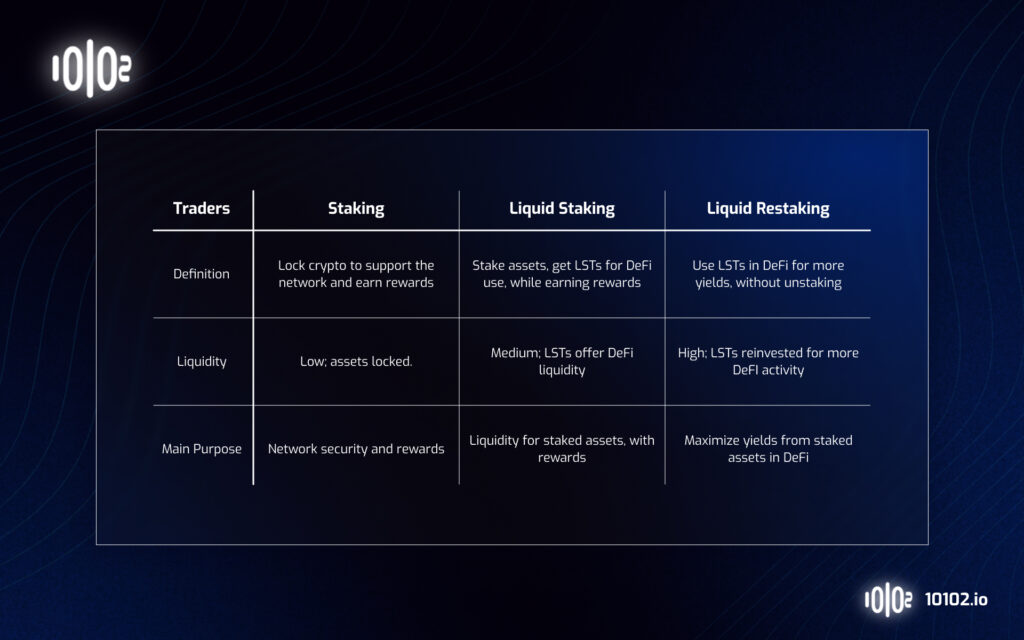Overview
Liquid restaking is an emerging concept in crypto that evolves from two foundational innovations:
- Liquid staking – which allows you to stake tokens (like ETH) and still use them elsewhere via liquid staking tokens (LSTs) such as stETH, rETH, or mETH.
- Restaking – which lets you reuse already staked assets to secure additional networks or services beyond the original blockchain, most notably via platforms like EigenLayer.
In short, Liquid Restaking Token (LRT) is tokenized receipt representing restaked ETH, allowing holders to access DeFi opportunities while still earning restaking rewards.

Key terms:
- Restaking: The process of reusing staked ETH to provide security for multiple protocols, enabling additional yield while maintaining Ethereum’s cryptoeconomic security.
- Actively Validated Service (AVS): A protocol or application that requires additional security beyond Ethereum’s base layer. AVSs rely on restakers to validate transactions or enforce cryptoeconomic guarantees. (Equivalent concepts exist in other ecosystems, such as Babylon for Bitcoin).
- Restaking Marketplace: An open market where AVSs offer yield to attract security and restakers delegate to validators/operators based on risk vs. reward incentives.
How Liquid Restaking Tokens (LRTs) Work
Given that most DeFi users are not actual validators, there’s a need to provide users with the ability to access the additional yield that restaking can provide easily.
Liquid restaking projects like Kelp and Ether.Fi are built on top of Ethereum and enable users to deposit Liquid Staking Tokens (LSTs) such as stETH or rETH, which are then allocated to validators that have opted into EigenLayer’s restaking marketplace.
In return, users receive Liquid Restaking Tokens (LRTs) like rsETH, which accrue both a) Ethereum staking rewards and b) additional restaking yield while remaining liquid for DeFi use.

The above graphic illustrates that an LST is restaked to an LRT project like Kelp, which is then delegated to EigenLayer in return for restaking rewards.
Key Considerations
- Increased Yield & Higher Slashing Risk: Restakers earn additional rewards by securing multiple AVSs, creating new income streams beyond Ethereum staking rewards. Validators securing multiple AVSs are exposed to more penalties, if an operator is slashed for one service, all restakers delegating to them may suffer losses.
- Smart Contract & Protocol Risk: Restaking and Liquid Restaking protocols rely on complex smart contracts, increasing the attack surface for exploits and governance risks.
- Liquidity Considerations: While Liquid Restaking Tokens (LRTs) provide flexibility, they may experience depegging risks in volatile market conditions, affecting tradability and collateral value.
- Ethereum Network Stability: If too much ETH is restaked across AVSs, a major slashing event could lead to mass liquidations, impacting Ethereum’s staking and validator ecosystem.
- Restaking and Liquid Restaking introduce new financial opportunities while extending Ethereum’s security model. However, risk management, validator selection, and protocol robustness are essential to maintaining long-term stability and sustainability.
Liquid Restaking Key Projects
There are 3 projects worth knowing about in liquid restaking space:
- EigenLayer: The pioneer and largest restaking protocol on Ethereum. Most other projects are built on top of
- Kelp: A liquid restaking protocol built on EigenLayer that issues Liquid Restaking Tokens (LRTs), enabling users to retain liquidity while restaking their assets.
- Ether.Fi: A liquid restaking protocol also built on EigenLayer, with some differences compared to Kelp such as around fees and governance.


